
The family Asteraceae, with the original name Compositae, consists of over 32,000 known species of flowering plants in over 1,900 genera within the order Asterales. Commonly referred to as the aster, daisy, composite, or sunflower family, Compositae were first described in the year 1740. The number of species in Asteraceae is rivaled only by the Orchidaceae, and which is the larger family is unclear as the quantity of extant species in each family is unknown.
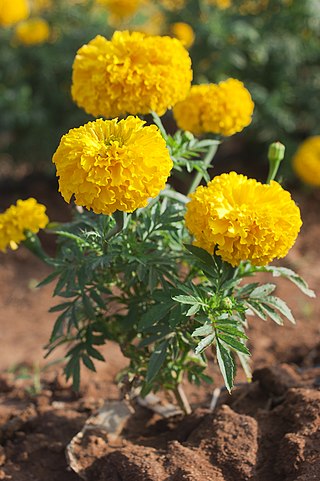
Tagetes is a genus of 50 species of annual or perennial, mostly herbaceous plants in the family Asteraceae. They are among several groups of plants known in English as marigolds. The genus Tagetes was described by Carl Linnaeus in 1753.
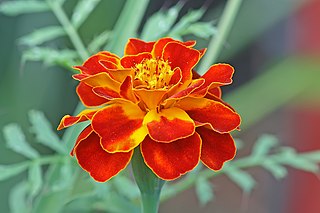
Tagetes patula, the French marigold, is a species of flowering plant in the family Asteraceae, native to Mexico and Guatemala with several naturalised populations in many other countries. It is widely cultivated as an easily grown bedding plant, with thousands of different cultivars in brilliant shades of yellow and orange.

Tagetes erecta, the Aztec marigold, Mexican marigold, big marigold, cempaxochitl or cempasúchil, is a species of flowering plant in the genus Tagetes native to Mexico and Guatemala. Despite being native to the Americas, it is often called the African marigold. In Mexico, this plant is found in the wild in the states of México, Michoacán, Puebla, Veracruz and Guerrero.

Calendula officinalis, the pot marigold, common marigold, ruddles, Mary's gold or Scotch marigold, is a flowering plant in the daisy family Asteraceae. It is probably native to southern Europe, though its long history of cultivation makes its precise origin unknown. It is also widely naturalised farther north in Europe and elsewhere in warm temperate regions of the world.

Tagetes lucida is a perennial plant native to Mexico and Central America. It is used as a medicinal plant and as a culinary herb. The leaves have a tarragon-like scent, with hints of anise, and it has entered the nursery trade in North America as a tarragon substitute. Common names include sweetscented marigold, Mexican marigold, Mexican mint marigold, Mexican tarragon, sweet mace, Texas tarragon, pericón, yerbaniz, and hierbanís.
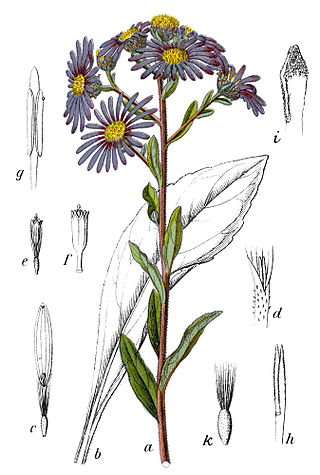
Asteroideae is a subfamily of the plant family Asteraceae. It contains about 70% of the species of the family. It consists of several tribes, including Astereae, Calenduleae, Eupatorieae, Gnaphalieae, Heliantheae, Senecioneae and Tageteae. Asteroideae contains plants found all over the world, many of which are shrubby. There are about 1,135 genera and 17,200 species within this subfamily; the largest genera by number of species are Helichrysum (500–600) and Artemisia (550).

Bidens laevis is a species of flowering plant in the daisy family known by the common names larger bur-marigold and smooth beggarticks. It is native to South America, Mexico, and the southern and eastern United States. It grows in wetlands, including estuaries and riverbanks.
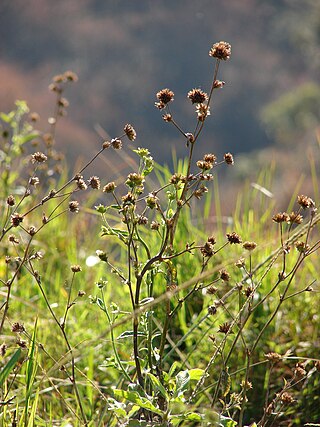
Elephantopus mollis, common names tobacco weed, and soft elephantsfoot, is a tropical species of flowering plant in the family Asteraceae.
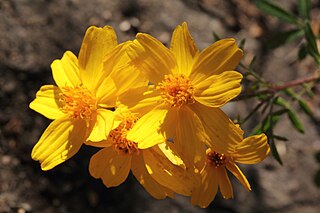
Tagetes lemmonii, or Lemmon's marigold, is a North American species of shrubby marigold, in the family Asteraceae. Other English names for this plant include Copper Canyon daisy, mountain marigold, and Mexican marigold.

Tagetes micrantha is a North American species of wild marigold within the family Asteraceae, common name licorice marigold. It is widespread across much of Mexico from Chihuahua to Oaxaca, and found also in the southwestern United States.
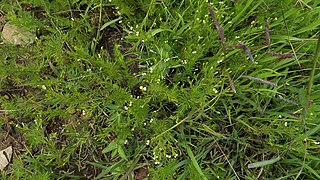
Tagetes filifolia is a New World species of marigolds in the family Asteraceae. It is widespread across much of Latin America from northern Mexico to Argentina. Common name is Irish lace despite the fact that the plant does not grow in Ireland.
Tagetes foetidissima is a Mesoamerican species of marigolds in the family Asteraceae. It is widespread across much of Mexico and Central America from Tamaulipas to Costa Rica. Common name is "flor de muerto," Spanish for "death flower."
Tagetes microglossa is a Mesoamerican species of marigold in the family Asteraceae. It grows in Central America, Colombia, and Ecuador, as well as in central and southern Mexico, from Jalisco to Chiapas.
Tagetes parryi is a Mesoamerican species of marigold in the family Asteraceae. It has been found only in the State of San Luis Potosí in northeastern Mexico.
Tagetes stenophylla is a Mexican species of marigold in the family Asteraceae. It has been found in the States of Guerrero, Jalisco, Morelos, Michoacán, and México State in western and central Mexico.
Tagetes elongata is a Latin American species of marigolds in the family Asteraceae. It has been found in central and southern Mexico from San Luis Potosí and Zacatecas south to Chiapas.
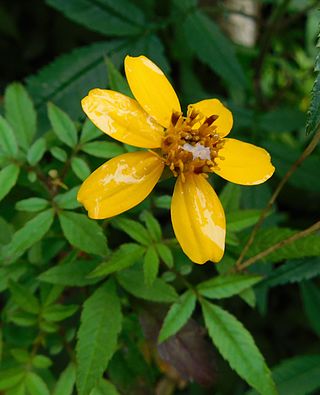
Tagetes nelsonii is a Mexican species of marigold in the family Asteraceae. It is native to Guatemala and to the State of Chiapas in southern Mexico.
Tagetes triradiata is a Mexican species of marigold in the family Asteraceae. It is native to central Mexico.
Tagetes pusilla, the lesser marigold, is a Latin American species of marigolds in the family Asteraceae. It is native Central America and western South America from Guatemala to northern Argentina.













